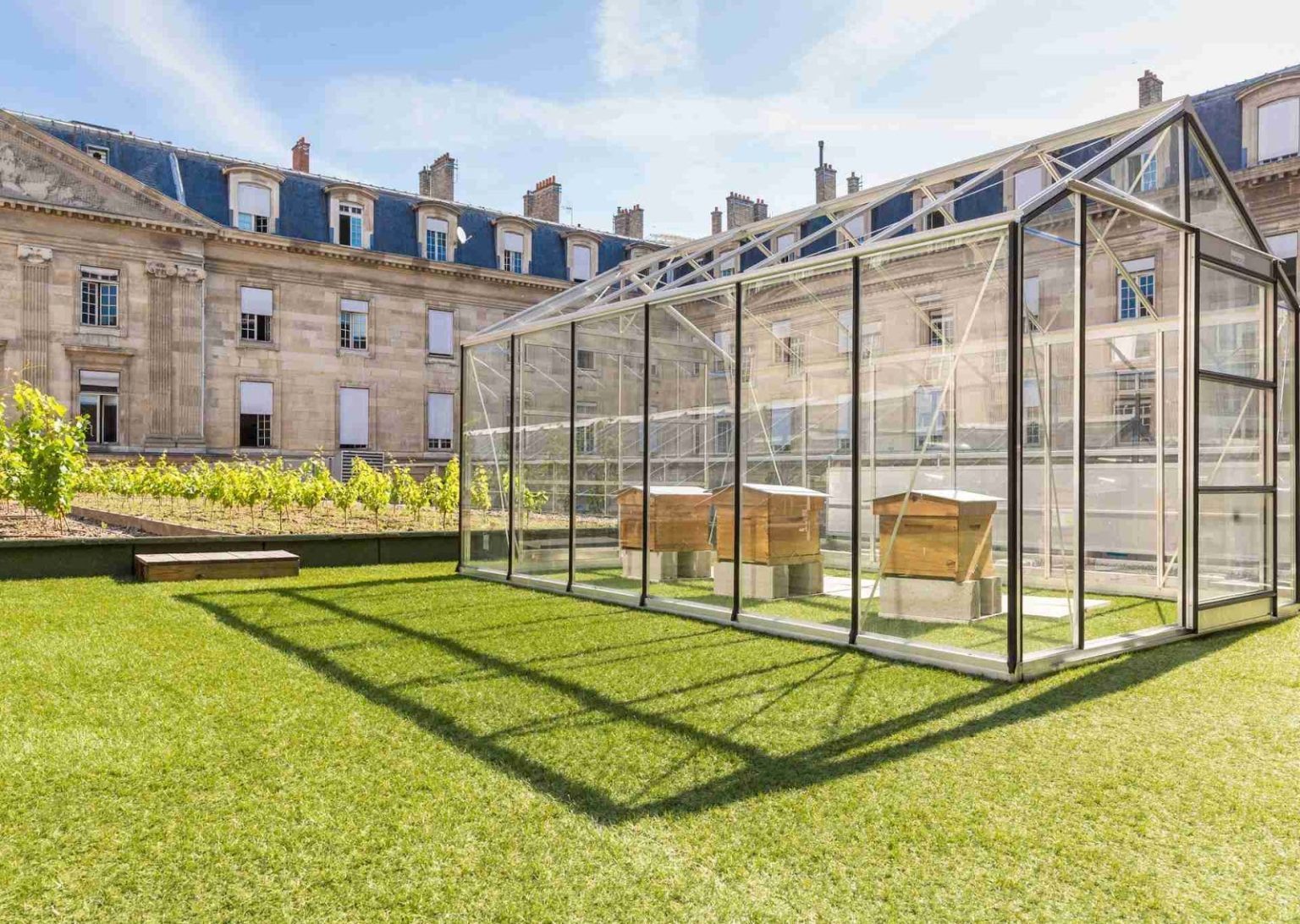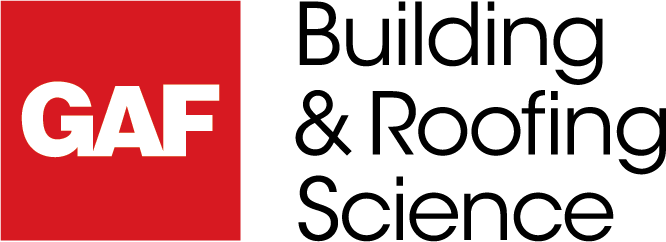AIA Course: #BE2022B
GBCI Course: #0920025999
Earn: 1.5 AIA LU/HSW; 1.5 IIBEC CEH; 0.1 IACET CEU; 1.5 GBCI CE Hours
To complete the quiz and receive a certificate of completion, follow this link: ce.buildingenclosureonline.com/BE2022B
Sponsored by:
Learning Objectives:
After reading this article, you should be able to:
- Define what is meant by overburden on a rooftop.
- Differentiate between vegetative roofs, blue roofs, blue-green roofs, and purple roofs.
- Understand roofing considerations for rooftop solar PV arrays.
- Recognize how selection and design of the roof assembly is critical for a long-lasting overburden installation.
- Review roof assembly design considerations including membrane thickness and color, roof attachment method, presence of a cover board, the importance of continuous control layers, and roof details and flashings.

Let’s Start with a Definition
In roofing, overburden is defined as “any manner of material, equipment or installation that is situated on top of, and covering all or a portion of, a roof or waterproofing membrane assembly.”1
This excludes thermal insulation but includes:
- Planters and everything they contain;
- Vegetative roof assemblies in trays, mats or other similar containers;
- Loose growing media, gravel, sand or any other granular material;
- Non-structural water features, inclusive of the water like water tanks, stormwater retention/detention, etc.;
- Void fill like EPS, XPS, and/or Polyiso rigid foam
- Plaza deck materials like tiles, pavers, supporting pedestals or other similar materials
- Equipment and/or installations like PV arrays2
Adhered TPO re-roof with solar photovoltaic panels on the Atlantic City Convention Center. Atlantic City, NJ. Photo courtesy of GAF.
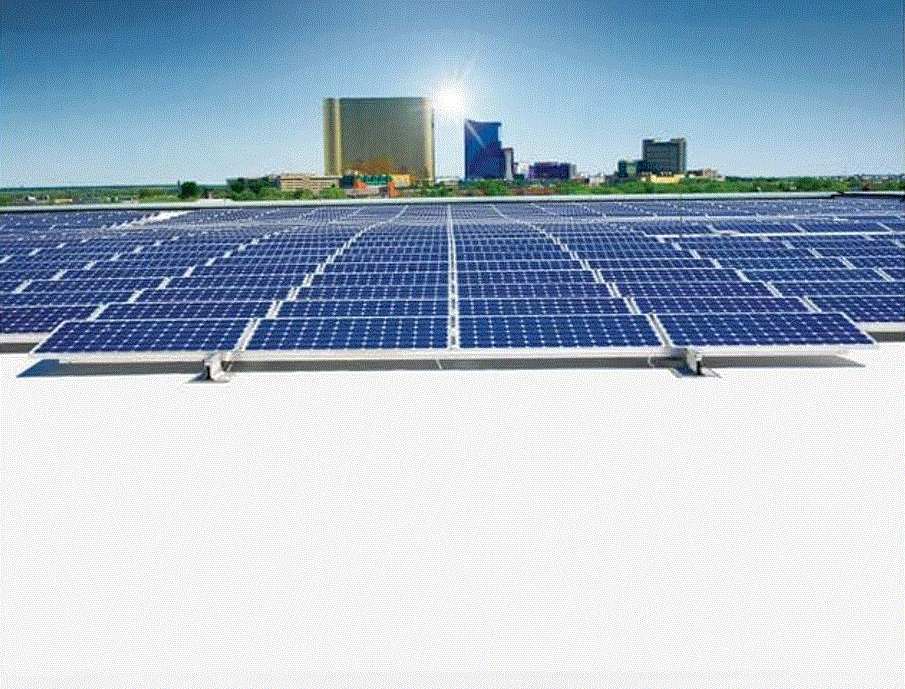
Introduction
Since its inception a roof’s primary purpose has been to shelter its inhabitants from the elements, but now the underutilized potential of roof surfaces is being realized. For roofs with large surface areas, the potential for large overburden installations, such as solar, vegetative roofing, or amenity decks can be exceptional. Even smaller roofs can have overburden that make a significant impact on the sustainability goals of a building including: increased energy efficiency, stormwater retention, energy generation, biohabitat restoration, food production, reduced urban heat island effect, and outdoor space.
Once thought to be a ‘burden’ for a roofing system, overburden benefits are increasingly emerging as a roofing advancement that's here to stay. In fact, according to Roofing Contractor magazine, vegetative roofs alone are expected to grow to $14 Billion per year by 2026.3 Similarly, according to the Solar Energy Industry Association (SEIA), “Double-digit growth in commercial solar volumes is expected for the next two years.” And, if there is “the passage of federal clean energy incentives, the commercial solar forecast would increase by 21 percent from 2022-2026.”4 Due to the increased frequency and intensity of severe rain-related events, roofs are now considered more often as part of an overall resiliency strategy to reduce flooding from stormwater runoff.
However, selection of the overburden system is only part of the design. Selection and design of the roof membrane, the waterproofing layer that protects the building, is critical for a long-lasting installation. Failure of the membrane, whether it requires repair or replacement, may necessitate removal of the overburden. The removal of the overburden can result in lost energy generation for solar installations, and loss of rainwater capture for both vegetative and blue or purple roof assemblies. Appropriate selection of the entire assembly, including proper detailing and integration of the roof assembly, as well as installation, are paramount to the overall success and longevity of the overburden system.
Overburden for Resilient Design
As defined by the Resilient Design Institute, “Resilience is the capacity to adapt to changing conditions and to maintain or regain functionality and vitality in the face of stress or disturbance. It is the capacity to bounce back after a disturbance or interruption.”5 Climate change related disasters are increasing in frequency, intensity, and cost. Buildings need to be prepared to manage not only the extreme weather related events but also the power outages, and health and safety risks that come along with them. Passive energy efficient design strategies, such as robust continuous insulation and airtightness, ensure that building tenants will be able to shelter in place for extended periods without power and not suffer consequences of extreme heat or extreme cold. By focusing on energy-efficiency first and then adding overburden strategies such as stormwater management, onsite renewables with battery storage, and food production to the roof, building tenants may have little interruption to normal daily activities.
While each property is unique, there are many overburden options and roof assembly considerations to meet increasingly stringent sustainability requirements. After the selection of the overburden type, the roof assembly will need to be determined, which is dependent on the type of overburden and the ultimate use of the roof space. The success of the overburden is dependent on the roof assembly beneath. Installations such as solar or vegetation, the plants and solar array will need to be removed for repairs or replacement. Considerations such as increased foot traffic, overburden movement, and leak detection should all be incorporated into the holistic overburden design. For example, a more robust membrane and integrated leak detection may be warranted for the long-term durability and serviceability of the complete roof and overburden assembly. Another approach is to look at “future-proofing” the roof with a performance-based view to the energy efficiency requirements for thermal insulation, thermal bridges, and air tightness versus simply following the prescriptive code minimum requirements to ensure a long-lasting roof assembly and to minimize the number of roof replacements over the life of the building.
Fun fact: According to Standard Industries, the rooftops of NYC’s 1 million buildings cover nearly 40,000 acres. Under the city’s landmark Climate Mobilization Act, all new buildings must be fitted with solar energy or a green roof. Think of all of the overburden possibilities just in NYC!
Overburden. Courtesy of Standard Industries.

Vegetative Roofs
Vegetative roofs can be installed in trays or built in-place on the roof with extensive or intensive plant configurations. Tray systems and extensive roofs are generally in depths of less than six inchesand consist of shallow rooted plants, such as sedums. Intensive vegetative roof systems have deeper soil depths and can accommodate larger plant installations. Soil mediums are engineered for specific installations that retain moisture, and are lighter when saturated so as to not overload roof structures. The benefits of vegetative roofs (also called green roofs, living roofs, and garden roofs) are well documented and can help achieve carbon reduction goals, and building resiliency through waste diversion, rainwater management, energy efficiency, increased biodiversity, and urban agriculture.
The benefits of vegetative roofs include and are not limited to:
- Extending the useful life of the roofing membrane by protecting it from expansion/contraction stresses due to temperature extremes, and ultraviolet light degradation.
- Managing and retaining rainwater in the substrate for the plants to use. The retention of rainwater helps not only to reduce the volume of water flowing onto impervious surfaces and into the sewer system, but reduces the strain on aging sewer infrastructure by increasing the speed of the flow of water.
- Increasing thermal efficiency by reducing heat loss.
- Biodiversity restoration in urban areas, which may also reduce the urban heat island effect.
- Reducing the ambient temperature on rooftops, thereby aiding solar arrays to function more efficiently and produce more energy.
- Supplying locally grown agriculture in urban “food deserts.”6
Blue Roofs
Beyond urban agriculture and clean energy generation, rooftops are now also improving on the rainwater management capabilities of vegetative roofs with “blue roof,” “blue-green roof,” and “purple roof” advancements. A blue roof is “a roof designed for the retention of rainwater above the waterproofing element of the roof. Blue roofs are typically flat [or low slope], without any fall, with control devices to regulate drainage outlets that enable water to be retained or drained.”7
“Blue roofs are systems that are designed to provide stormwater detention. Rainfall onto the roof is managed using orifices, weirs, or other outlet devices that control the discharge rate of rooftop runoff. By reducing flow rates from rooftops, blue roofs are effective in reducing the size of downstream detention basins.”8 Blue roofs retain water through passive orifice restriction or detain water through an active mechanical valve or gate apparatus. Similar to a bathtub or sink overflow drain, blue roofs also incorporate an overflow drain to prevent spillover.
Section detail of a blue roof. Courtesy of NJ.gov.
Figure 1
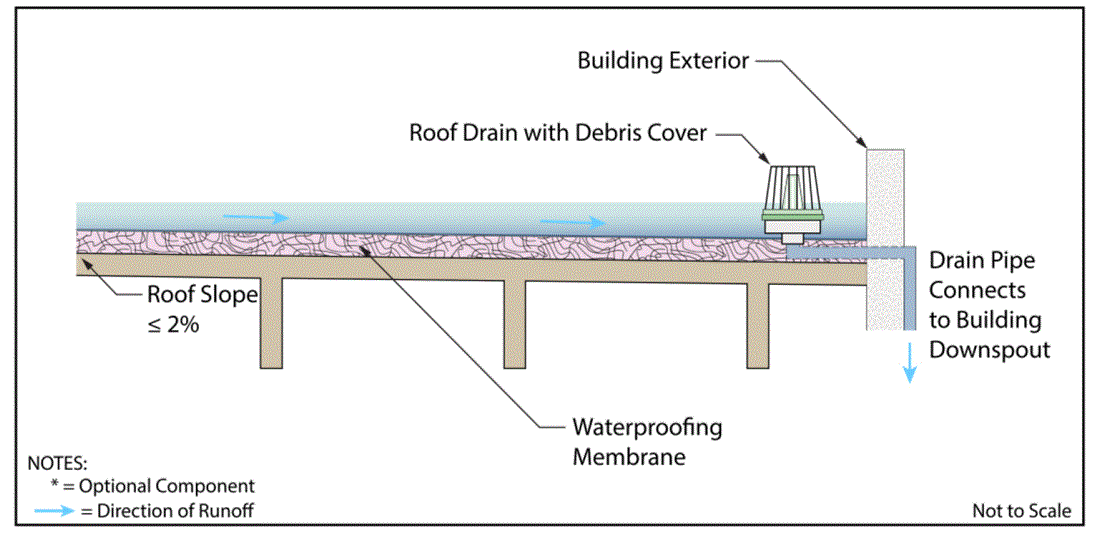
Clog prevention for blue roofs. Courtesy of NJ.gov.
Figure 2
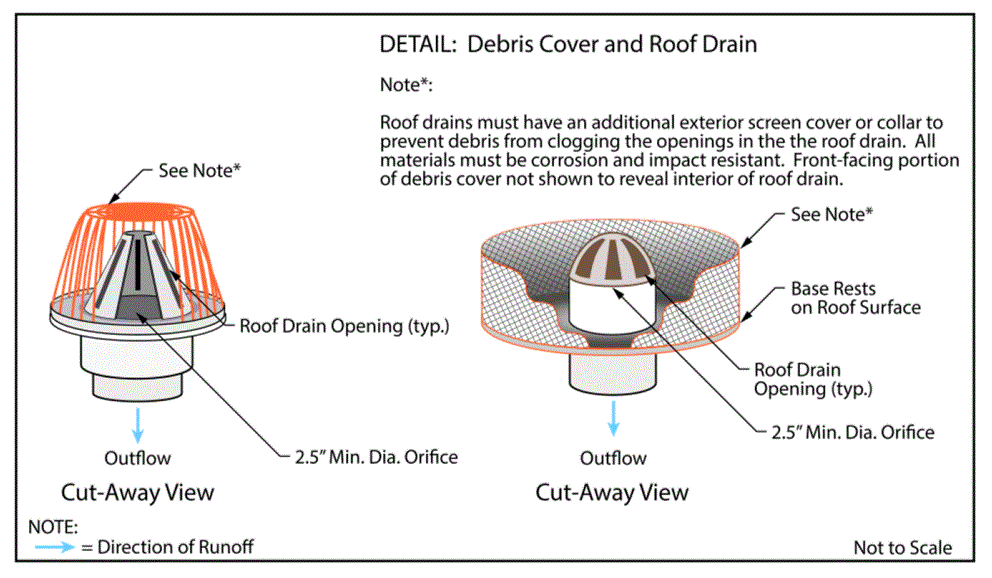
Blue Roof Considerations
There are a number of considerations for blue roofs to manage stormwater runoff. Including safe rooftop access to the blue roof for maintenance and/or public roof access. The structural load capacity of the roof should also be considered as the retained water on the roof and the catchment system can significantly add weight to the structure. In addition, integrated leak detection strategies and regular inspections and maintenance plans to prevent clogged drains should be incorporated into the design. Considering the longevity and durability of the blue roof accessories and waterproofing layer is of the utmost importance. Leaks are costly to repair and can create a cascade of problems including but not limited to: mold & mildew, poor indoor air quality, corrosion and rotting of building materials, and ultimately structural failure. Extreme care must be taken to ensure that the waterproofing membrane is not damaged. Lastly, rooftop equipment (including solar arrays and electrical connections) should be protected to ensure that it is not damaged as a result of ponding water.9
General Maintenance
According to the New Jersey Stormwater Best Management Practices Manual,
“Blue roofs should be inspected at least four times annually and after every storm event exceeding 1 inch of rainfall. Blue roofs located in areas with significant tree cover or in areas with a high potential for airborne debris may require more frequent inspections due to the potential for clogging. All structural components should be inspected for cracking, spalling and deterioration at least once annually. Disposal of debris, trash, sediment and other waste material must be done at suitable disposal/recycling sites and in compliance with all applicable local, state and federal waste regulations. Access points for maintenance are required on all blue roofs; these access points should be clearly identified in the maintenance plan. In addition, any special training required for maintenance personnel to perform specific tasks should be included in the plan. The design drain time for the maximum design storm runoff volume must be indicated in the maintenance plan. If the actual drain time is longer than the design drain time, the blue roof must be evaluated and appropriate measures taken to return the blue roof to the as-built condition. If the blue roof fails to fully drain within 72 hours, corrective action must be taken and the maintenance manual revised accordingly to prevent similar failures in the future.”10
Potable Water Considerations - NSF P151
Before the introduction of modern drinking water facilities, captured rainwater was one of the best ways to ensure communities had a sufficient supply of water. Parts of the world still rely heavily on rainwater as the main source of drinking water. In order to ensure the safety and health of using captured rainwater for potable water, the NSF established the Rainwater Catchment System Components program, which provides testing guidelines for all components that come into direct contact with rainwater to be used for drinking. The NSF P151 protocol confirms that products do not impart contaminants into the drinking water. When considering using captured rainwater from blue roofs in storage tanks or cisterns, all components should have NSF P151 certification to ensure safe drinking water.11
Blue-Green Roofs
A blue-green roof is a blue roof with a vegetative roof assembly, as well. The added vegetation acts as a biological sponge to reduce the amount of rainwater runoff while, at the same time, slowing the rate at which rainwater runs off. Or, in other words, “The blue green roof combines blue and green roof technologies. Conventional green roofs use a drainage layer to provide lateral drainage and irrigation. Blue roof technology, however, aims to increase both the volume of water stored and control the amount of water released. Combining the technologies can increase the overall benefits of greening roof scapes. Therefore, it is not a case of green or blue infrastructure but a blending of the both”.12
“Blue-green roofs are roof assemblies wherein live vegetation and various substrate layers are used for rainwater detention as part of a stormwater management strategy”13“Blue-green roofs can be distinguished from conventional green roofs in that blue-green roofs provide a larger amount of detention.”14
“(Temporary storage) of stormwater in addition to existing retention (evaporation) capacities, enhance the roof’s ability to delay and reduce stormwater runoff”15 and amplifies the benefits of blue-green roofs in urban areas.
According to Busker et al, “Runoff reductions during extreme precipitation of 70–97 percent were found.” And, “This is much higher than runoff reductions found for a conventional green roof (12 percent).”16 By reducing runoff, there is less strain on sewer systems and less water flooding impervious surfaces such as streets and hardscapes.
Section detail of a blue-green roof mounted on a conventional roof. Courtesy of Buildings.
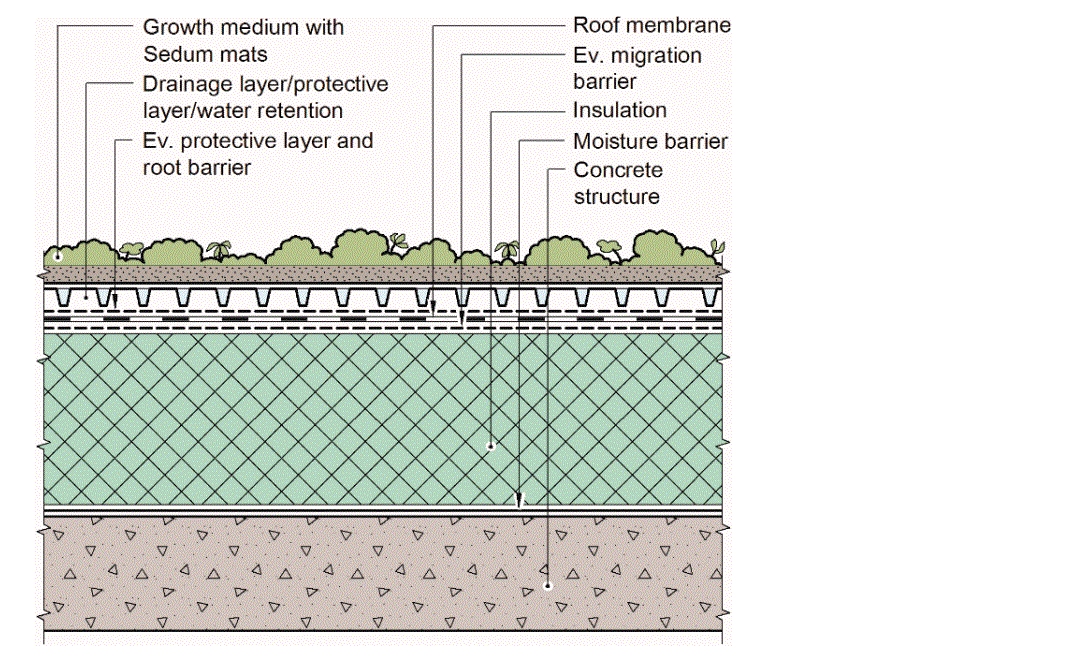
Figure 3
Purple Roofs
A purple roof is a “sponge” roof that incorporates a sponge-like layer made of hydrophilic mineral wool, a dense polyester fabric detention layer, and may or may not include an additional honeycomb layer to increase the volume of rainwater that can be retained and detained and reduces peak outflow by up to 95 percent.17(See Figure 4).
Section detail of a purple roof assembly with vegetative roof. Courtesy of Roof Diagnostics, Inc.

Figure 4
In addition, purple roofs may or may not include a vegetative roof. Pavers on pedestals for amenity decks can also use purple roof strategies.18 (See Figure 5 & Figure 6.)
Section detail of a purple roof assembly with pavers on pedestals. Courtesy of Roof Diagnostics, Inc.

Figure 5
The layers of a purple roof. Courtesy of Roof Diagnostics, Inc.
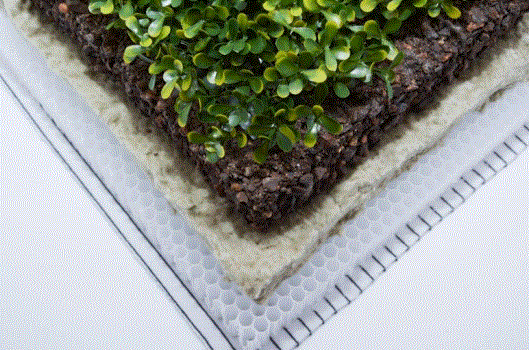
According to Brad Garner from Roof Diagnostics, Inc., the hydrophilic needled mineral wool layer can reach 50 - 60 percent saturation before it starts releasing water, or “outflowing.” Once the mineral wool is saturated, the water flows gravitationally into the honeycomb matrix. The honeycomb matrix can be installed in thicknesses from ½ inch to 4 inches depending on the peak rainfall storage needs of the project. The key differentiating factor of purple roofs is the combination of the mineral wool and the added high density polyester fabric detention layer. The detention layer functions like mini gates to detain the water. The mineral wool then dissipates the detained water through evaporation or evapotranspiration through the vegetated layer. The honeycomb layer is added for extra water storage capacity.
Example of a purple roof diagrammatic hydrograph showing the slow release of stormwater over several days. Courtesy of SemperGreen USA.

Figure 6
Example of a purple roof hydrograph showing the peak rain event and the slow release of stormwater runoff over time. Courtesy of SemperGreen USA.
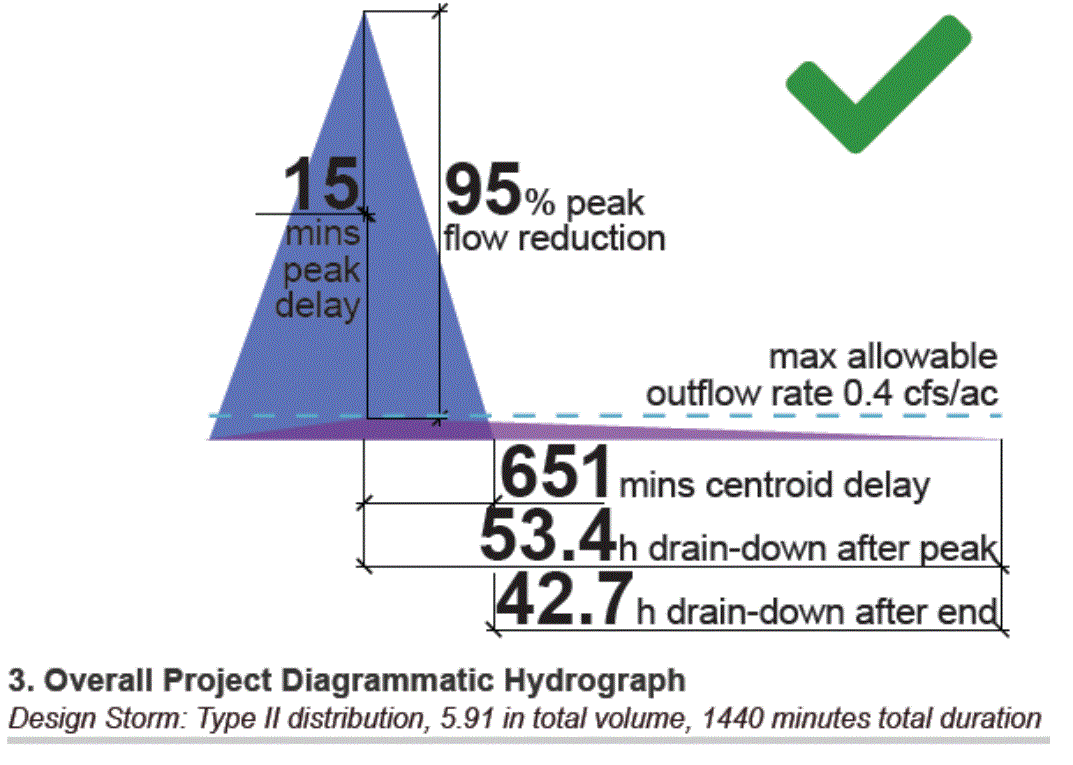
Figure 7
Rooftop Solar
According to SEIA, “Solar power is energy from the sun that is converted into thermal or electrical energy. Solar energy is the cleanest and most abundant renewable energy source available, and the U.S. has some of the richest solar resources in the world. Solar technologies can harness this energy for a variety of uses, including generating electricity, providing light or a comfortable interior environment, and heating water for domestic, commercial, or industrial use.”19 While there are numerous ways to benefit from the solar energy the sun creates including energy generation, hot water, passive solar heat gains, and passive daylighting; for the purposes of this article, photovoltaic energy generation will be the focus.
“Photovoltaic (PV) devices generate electricity directly from sunlight via an electronic process that occurs naturally in certain types of material, called semiconductors. Electrons in these materials are freed by solar energy and can be induced to travel through an electrical circuit, powering electrical devices or sending electricity to the grid.”20 “Photons strike and ionize semiconductor material on the solar panel, causing outer electrons to break free of their atomic bonds. Due to the semiconductor structure, the electrons are forced in one direction creating a flow of electrical current. Solar cells are not 100 percent efficient in crystalline silicon solar cells, in part because only certain light within the spectrum can be absorbed. Some of the light spectrum is reflected, some is too weak to create electricity (infrared) and some (ultraviolet) creates heat energy instead of electricity.”21
End Notes
1Architecture 2030. “Accelerating to Zero by 2040!” Oct. 2019. Web. 22 Feb. 2022. <https://architecture2030.org/accelerating-to-zero-by-2040/ >
2https://www.un.org/en/academic-impact/sustainability Accessed 2/4/2022 at 9:33am.
3Intergovernmental Panel on Climate Change. “Climate Change 2021: The Physical Science Basis Working Group I: Contribution to the Sixth Assessment Report of the Intergovernmental Panel on Climate Change.” Oct. 2021. Web. 4 Feb. 2022. <https://www.ipcc.ch/report/ar6/wg1/downloads/report/IPCC_AR6_WGI_SPM_final.pdf>
4National Oceanic and Atmospheric Administration (NOAA). “2021 U.S. billion-dollar weather and climate disasters in historical context.” 24 Jan. 2022. Web. 6 Feb 2022.
5Intergovernmental Panel on Climate Change. “Climate Change 2021: The Physical Science Basis Working Group I: Contribution to the Sixth Assessment Report of the Intergovernmental Panel on Climate Change.” Oct. 2021. Web. 4 Feb. 2022. <https://www.ipcc.ch/report/ar6/wg1/downloads/report/IPCC_AR6_WGI_SPM_final.pdf>
6Headline Statements. Intergovernmental Panel on Climate Change. Web. 8 Feb. 2022. <https://www.ipcc.ch/sr15/resources/headline-statements/>
7Architect Magazine Staff and Mazria, Edward. “Architecture 2030's Open Letter to the UN Framework Convention on Climate Change Calls for Revised Carbon Emission Reduction Targets.” Architect Magazine, 6 Nov. 2020. Web. 18 Feb. 2022. <https://www.architectmagazine.com/technology/architecture-2030s-open-letter-to-the-un-framework-convention-on-climate-change-calls-for-revised-carbon-emission-reduction-targets_o>
8Pedersen, Martin C. “Edward Mazria With Some Good News About Combating Climate Change.” “Common Edge,” 27 July 2020. Web. 9 Feb. 2022. <https://commonedge.org/edward-mazria-with-some-good-news-about-combating-climate-change/>
9Carbon Leadership Forum. “Embodied Carbon 101.” 17 Dec. 2020. Web. 8 Feb. 2022. <https://carbonleadershipforum.org/embodied-carbon-101>
10NYC Mayor’s Office of Climate & Environmental Justice. “Energy Benchmarking:
Energy map.” New York City Energy & Water Performance Map.” Web. 8 Feb. 2022. <https://www1.nyc.gov/site/sustainability/codes/energy-benchmarking.page#:~:text=Over 70 percent of New,on energy and water management>
11Center for Sustainable Systems, University of Michigan. 2021. "U.S. Cities Factsheet." Pub. No. CSS09-06. Web. 8 Feb 2022. <https://css.umich.edu/factsheets/us-cities-factsheet#:~:text=It is estimated that 83,to live in urban areas>
12Saulsbery, Gabrielle. “Peak Demand: Parsippany-based GAF addresses a serious labor shortage by training new roofers.” NJBiz. 17 May 2021. Web. 17 Feb. 2022. <https://njbiz.com/peak-demand-gaf-roofer-training/>
13La Rocca, Melanie E. “Service Notice: Local Law 92 of 2019 and Local Law 94 of 2019: Green and Solar Roof Requirements for New Buildings and Complete Roof Replacements.” NYC.gov. Oct. 2019. Web. Feb 9 2022. <https://www1.nyc.gov/assets/buildings/pdf/green_roof_solar_ll92-n-94of2019_sn.pdf>
14Urban Green Council and The Nature Conservancy. “NYC’S SUSTAINABLE
ROOF LAWS.” Urban Green Council. Dec. 2019. Web. 10 Feb. 2022. <https://www.urbangreencouncil.org/sites/default/files/sustainable_roof_laws_brief_final_12.11.19.pdf>
15Torgelson, Nathan. “Seattle Green Factor.” Seattle.gov. Web. 18 Feb. 2022. <https://www.seattle.gov/sdci/codes/codes-we-enforce-(a-z)/seattle-green-factor#:~:text=You can choose from a,or create a food garden>
16Seattle Department of Construction & Inspections. “Renewable Energy and Solar-Ready Roofs for Commercial Buildings.” Seattle.gov. 18 Oct 2021. Web. 14 Feb 2022. <http://www.seattle.gov/DPD/Publications/CAM/Tip422.pdf>
17Washington, D.C. Department of Energy & Environment. “Green Roofs in the District of Columbia.” Web. 22 Feb. 2022. <https://doee.dc.gov/greenroofs>
18Washington, D.C. Department of Energy & Environment. “Solar Initiatives.” Web. 22 Feb. 2022.
19World Green Building Council. “Whole Life Carbon Vision.” WorldGBC.org. Web. 4 Feb. 2022. <https://www.worldgbc.org/advancing-net-zero/whole-life-carbon-vision>
20Tobias, Michael. “Green Building Trends: Pros & Cons of Passive House Construction.” NewYork Engineers. 12 October 2021. Web. 17 Feb. 2022. <https://www.ny-engineers.com/blog/green-building-trends-pros-cons-of-passive-house-construction>
21Taylor, T.J. “Eliminating Fastener Thermal Bridging in Low Slope Roofs: Energy Efficiency Savings versus Installation Costs.” Open Journal of Energy Efficiency. 9, 94-110. June 2022. Web. 20 Feb. 2022. < https://doi.org/10.4236/ojee.2020.92007>
22Ibid.
23World Green Building Council. “Whole Life Carbon Vision.” WorldGBC.org. Web. 4 Feb. 2022. <https://www.worldgbc.org/advancing-net-zero/whole-life-carbon-vision>
24Ellen MacArthur Foundation. “What is a circular economy?” Web. 17 Feb 2022. <https://ellenmacarthurfoundation.org/topics/circular-economy-introduction/overview>
25Reuters. “U.S. corn-based ethanol worse for the climate than gasoline, study finds.” Autoblog. 21 Feb. 2022. Web. 2 Feb 2022.
26GAF Roof Views. “Welcome to the Future of Asphalt Recycling.” GAF.com. 21 April 2021. Web. 17 Feb 2022. <https://www.gaf.com/en-us/blog/welcome-to-the-future-of-asphalt-recycling-281474980090173>
27MYCOCYCLE. Web. 22 Feb 2022. <https://mycocycle.com/>
28Acaroglu, Leyla. “The Trap of Wishcycling.” Disruptive Design. 8 Sep. 2021. Web. 22 Feb. 2022. <https://medium.com/disruptive-design/the-trap-of-wishcycling-6ea083646876>
29Siegel, Henry and Strain, Larry. “Embodied Carbon: What you Can Do Right Now.” AIA California. 5 March 2020. Web. 8 Feb. 2022. <https://aiacalifornia.org/embodied-carbon-definitions-and-facts/>
30Nadeeshani, Malka et al. “Carbon Footprint of Green Roofing: A Case Study from Sri Lankan Construction Industry.” Sustainability 2021, 13, 6745. 15 June 2021.
31Clancy, Heather. “Carbon-sucking concrete is capturing attention and funding.” GreenBiz. 6 May 2021. Web. 17 Feb. 2022. <https://www.greenbiz.com/article/carbon-sucking-concrete-capturing-attention-and-funding>
32PLC-Portland Limestone Cement. “Portland-Limestone Cement U.S. Fact Sheet.” Greener Cement. Web. 17 Feb. 2022. <https://www.greenercement.com/_files/ugd/f3d485_bf593dd744f049d98cbd293109fc42ce.pdf>
33Tosti, Lorenzo et al. “Technical and environmental performance of lower carbon footprint cement mortars containing biomass fly ash as a secondary cementitious material.” Resources, Conservation and Recycling. Volume 134. July 2018.<https://doi.org/10.1016/j.resconrec.2018.03.004>
34.Overbey, Daniel. “Defining a Whole-Building Embodied Carbon Workflow.” Building Enclosure. 30 June 2021. Web. 9 Feb. 2022. <https://www.buildingenclosureonline.com/blogs/14-the-be-blog/post/89961-defining-a-whole-building-embodied-carbon-workflow>
35Alter, Lloyd. “New Tool Calculates Full Life Cycle Carbon Emissions for Passive House.” Treehugger. 25 Jan 2022. Web. 9 Feb 2022. <https://www.treehugger.com/tool-lifecycle-carbon-emissions-passive-house-5216866>
36International Living Future Institute and Passive House Institute. “Zero Energy &
Passive House Certifications.” 2019. Web 22 Feb. 2022. <https://living-future.org/wp-content/uploads/2019/07/Zero_Energy_PassiveHouse_Crosswalk-1.pdf>
37Ibid.
38Resilient Design Institute. “What is Resilience?” Resilient Design. Web. 4 Feb. 2022. <https://www.resilientdesign.org/defining-resilient-design/>
39Roofing Contractors Association of British Columbia. “Template: ROOFTOP EQUIPMENT & WALKWAYS (BUR).” Web. 4 Feb. 2022. <https://rpm.rcabc.org/index.php/Template:ROOFTOP_EQUIPMENT_&_WALKWAYS_(BUR>
40Green Roofs for Healthy Cities. “About Green Roofs.” Greenroofs.org. Web 10 Feb. 2022. <https://greenroofs.org/about-green-roofs>
41Simon, Matt. “Your Rooftop Garden Could Be a Solar-Powered Working Farm.” “Wired,” 3 Dec. 2021. Web. 17 Feb. 2022. <https://www.wired.com/story/your-rooftop-garden-could-be-a-solar-powered-working-farm/>
42Urban Green Council and The Nature Conservancy. “NYC’S SUSTAINABLE
ROOF LAWS.” Urban Green Council. Dec. 2019. Web. 10 Feb. 2022. <https://www.urbangreencouncil.org/sites/default/files/sustainable_roof_laws_brief_final_12.11.19.pdf>
43Ibid.
44Javits Center. “Green Roof Tours.” Javits Center. Web 7 Feb. 2022. <https://javitscenter.com/sustainability/green-roof-tours/>
45Sokol, David. “Rooftop Farm Soars Above the City.” Architectural Record. 15 Dec. 2021. Web. 7 Feb. 2022. <https://www.architecturalrecord.com/articles/15429-rooftop-farm-soars-above-the-city>
46Designing Buildings. “Blue Roof.” 15 Dec. 2021. Web. 22 Feb. 2022. <https://www.designingbuildings.co.uk/wiki/Blue_roof>
47Livingroofs.org. “The blue green roof—helping cities cope with stormwater.” Web. 22 Feb. 2022. <https://livingroofs.org/introduction-types-green-roof/blue-green-roof-cities-stormwater/>
48SemperGreen USA. “Purple-Roof Case Study.” 12 Oct. 2021. Web. 22 Feb. 2022. <https://www.sempergreen.com/en/sempergreen-academy/webinar-innovation-for-future-proof-cities>
Shawn Torbert, M.S., CPHC/D, LEED AP is the Commercial Design Sustainability Manager at GAF. Kristin Westover, P.E., LEED AP O+M is a Technical Manager of Specialty Installations for GAF. Kristin and Shawn are part of the Building & Roofing Science Team providing technical thought leadership in the roofing industry while helping designers make informed decisions.
Quiz
1. Sustainability is:
- A marketing strategy used by businesses to increase profits.
- A holistic strategy to meet the needs of the present without compromising the ability of future generations to meet their own needs.
- A political wedge used by politicians to get re-elected.
- A financial strategy to de-risk investments.
2. What does the International Panel on Climate Change conclude about climate change?
- Local weather is the same thing as global climate systems.
- The global warming data can be explained by an array of variables including technological advancements in modeling and monitoring, population growth, and natural phenomenon such as solar storms and volcanoes.
- There is plenty of time to debate whether climate change is happening or not.
- It is unequivocal that human influence has warmed the atmosphere, ocean and land. Widespread and rapid changes in the atmosphere, ocean, cryosphere and biosphere have occurred.
3. In U.S. cities, approximately what percentage of emissions come from buildings?
- 20 percent
- 50 percent
- 70 percent
- 100 percent
4. Net-zero operational carbon is:
- A highly energy-efficient building with all remaining energy from onsite and/or offsite renewable sources.
- A code-built building whose owner has purchased enough carbon offsets through tree plantings to claim net-zero energy status.
- A unicorn. There’s no such thing as net-zero energy buildings.
- A building that is highly efficient with upfront carbon minimized to the greatest extent possible and all remaining embodied carbon is reduced or, as a last resort, offset.
5. Net-zero embodied carbon is:
- A highly energy-efficient building with all remaining energy from onsite and/or offsite renewable sources.
- A building that is highly efficient with upfront carbon minimized to the greatest extent possible and all remaining embodied carbon is reduced or, as a last resort, offset.
- A unicorn. There’s no such thing as net-zero embodied carbon buildings.
- A building that is built only from natural materials that have been sourced locally using only manual labor or beasts of burden for transportation and construction.
6. Whole life carbon is:
- The total amount of carbon emissions released by disposing of a roof in a landfill.
- The total amount of carbon captured by planting trees to offset building material embodied carbon.
- An ancient industrial process that uses highly pressurized gases inside solidified carbonite to preserve biological organisms for intergalactic travel.
- The sum of operational carbon and embodied carbon.
7. Overburden is:
- Any manner of additional load on a roof from snow, severe hail, or wind.
- Any manner of material, equipment or installation that is situated on top of, and covering all or a portion of, a roof or waterproofing membrane assembly.
- Any manner of severe storm or “bomb cyclone” that floods sewer systems and impervious surfaces with rainwater.
- None of the above.
8. Roofs can significantly reduce the operational carbon of buildings by including:
- A thermal-bridge free roof assembly with the roof assembly seamlessly integrated into the vertical wall air barrier.
- Robust climate-specific levels of continuous insulation.
- Rooftop solar.
- All of the above
9. A purple roof refers to:
- The color of the roof membrane.
- The color of the cover board used on flat/low-slope roof.
- A roof that incorporates rainwater retention and detention with a sponge-like layer made of hydrophilic mineral wool to increase the volume of rainwater that can be retained or detained and reduces peak outflow by up to 95 percent.
- All of the above
10. In tropical climates, the lifecycle carbon emissions of a concrete roof can be reduced nearly 85 percent by:
- Adding fly ash to the concrete mix.
- Recycling the concrete at the end of its useful life.
- It can’t be done. Concrete and steel have too much embodied energy from their heavy manufacturing processes.
- A vegetated roof.
